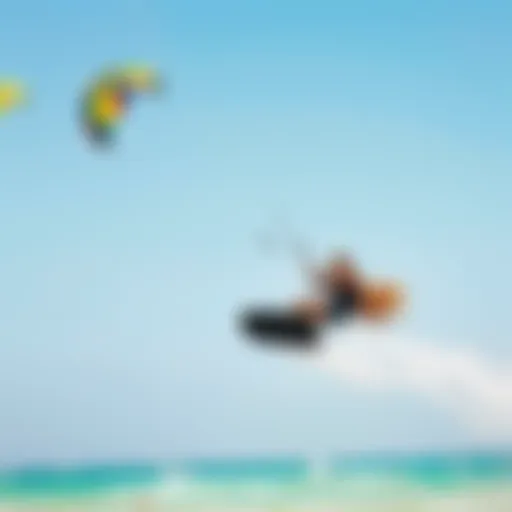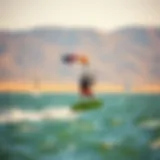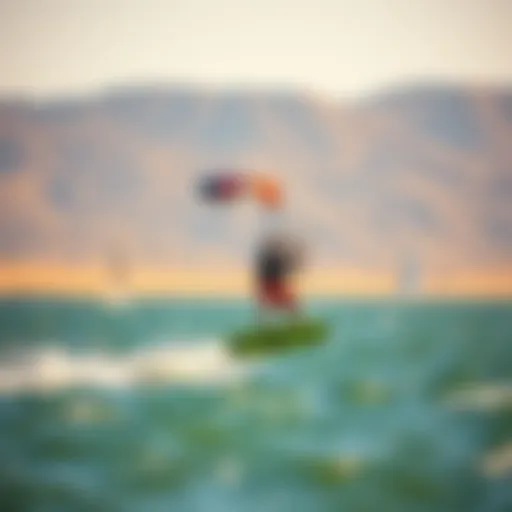Essential Kitesurfing Gear for Beginners: A Comprehensive Guide
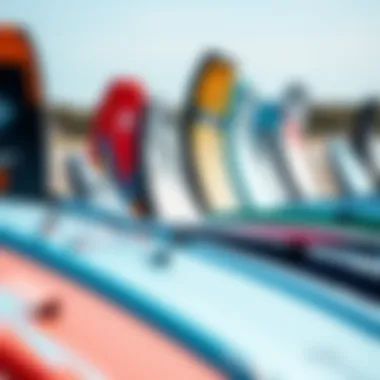
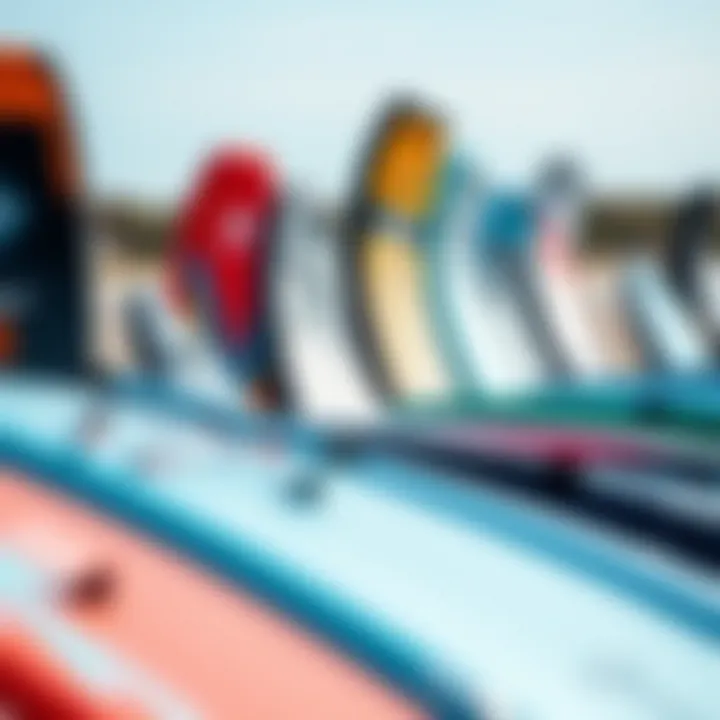
Intro
Kitesurfing combines the thrill of surfing with the exhilaration of flying, making it a sport that draws enthusiasts from all corners of the globe. However, before you can catch that wind and ride those waves, there’s some groundwork to cover. This guide aims to arm you with knowledge about the essential gear required for beginners. You'll find insights into the various pieces of equipment, how they work together, and what to consider when making your purchases.
Understanding the right equipment is crucial for a safe and enjoyable experience on the water. It’s not just about aesthetics; each item serves a specific purpose and contributes to your performance and safety. Let’s first dive into the details of the equipment you’ll need to get started on your kitesurfing journey, making sure that you approach this thrilling sport with confidence.
Understanding Kitesurfing
Kitesurfing is more than just a thrilling water sport; it's a dance with the wind and waves that comes with a unique connection to nature. Whether you’re a seasoned adventurer or someone just dipping your toes into water sports, grasping the ins and outs of kitesurfing is essential. Understanding the fundamentals not only enhances the experience but also prioritizes safety and skill development.
Overview of the Sport
At its core, kitesurfing involves riding a board on water while being propelled by a large kite. The kite is controlled via a series of lines connected to a bar. Essentially, you harness the wind's power, turning it into a fun and dynamic ride across the waves. This sport has its roots in various other activities like surfing and windsurfing, but it uniquely combines elements of each, giving enthusiasts varied styles and tricks to learn.
Moreover, kitesurfing offers a range of environments, from flat lakes to raging oceans, providing different challenges and experiences for riders. The sensation of gliding across the water, coupled with the ability to catch air for jumps and tricks, creates an exhilarating sense of freedom. With every gust of wind, kitesurfing continues to draw individuals seeking both adventure and a deep appreciation for the elements.
Growth of Kitesurfing as an Activity
In recent years, kitesurfing has witnessed significant growth, attracting a diverse mix of enthusiasts. What started as a subculture soon blossomed into a major recreational activity embraced worldwide. Several people have taken to the sport thanks to advancements in equipment design and teaching methods. The simplicity of blowing up a kite and hitting the water has turned kitesurfing into an accessible hobby for many.
"Kitesurfing isn't just a sport; it’s a lifestyle that brings communities together in stunning locations."
Regions with consistent wind patterns and beautiful coastlines, such as Tarifa in Spain or the beaches of Maui, have seen a surge of kitesurfing schools, with passionate instructors eager to share their knowledge. As more people engage in kitesurfing, it fosters a community of enthusiasts connecting over shared experiences, techniques, and environmental care.
Factors like social media, online tutorials, and competitions have significantly contributed to the sport's visibility, making it appealing to younger generations eager for excitement and community. As the sport grows, so does the innovation behind more effective learning tools, helpful gear, and improved safety measures, ensuring that both newcomers and experts have a rich kitesurfing journey ahead.
Understanding kitesurfing lays the groundwork for diving deeper into the specific equipment required to begin this thrilling adventure, ensuring that beginners approach the sport equipped with both knowledge and safety.
Core Equipment Essentials
Understanding the fundamental pieces of kitesurfing gear is a game-changer for any beginner. The right equipment not only enhances your experience on the water but also significantly contributes to safety and performance. If you've ever felt overwhelmed by the sheer number of options available, you're not alone. To navigate this intricate landscape, it's crucial to grasp how each piece of equipment plays a role in your overall kitesurfing adventure.
Kite Types and Their Characteristics
Choosing the right type of kite can make or break your kitesurfing journey. Each kite type comes with its own characteristics and appeals to different skill levels and wind conditions. Let's dissect the three primary types you'll encounter.
Foil Kites
Foil kites are designed with multiple cells creating a parachute-like shape. This unique design enables the kite to remain inflated even in low wind conditions, making it an appealing choice for beginners looking to hone their skills without heavy winds. An important characteristic of foil kites is their ability to generate lift, allowing for smoother rides. However, they might not perform as well in strong winds compared to other kite types. If you're after a quiet, high-efficiency kite, then a foil might just fit the bill.
LEI Kites
Leading Edge Inflatable (LEI) kites are the bread and butter of the kitesurfing world. They’re characterized by an inflatable leading edge that provides structure and stability in various wind conditions. Their buoyancy makes them easy to relaunch from the water, a major plus for beginners. On the flip side, they can be a bit bulky to transport and may require more care than foil kites. But for a beginner eager to explore the full range of techniques, LEI kites are arguably the most versatile option.
Hybrid Kites
Hybrid kites combine elements from both foil and LEI kites, making them a sort of jack-of-all-trades in the kitesurfing realm. This design often caters to varied wind conditions and skill levels, offering a flexible experience. People often choose hybrids for their balanced performance, striking a middle ground between lift and stability, a comforting choice for those still finding their footing. However, the intricacies of their design mean they may lack the specialized performance of pure LEI or foil kites in specific scenarios.
Control Systems Explained
Once you've got your kite picked out, understanding the control systems is next on the to-do list. This is where you’ll manage the power and maneuverability of your kite. Having a grasp of how bars, lines, and depower systems work is essential for any budding kitesurfer.
Bars and Lines
Bars serve as the interface between the kitesurfer and the kite itself. They control the direction and power of the kite while affording some safety features. A key aspect is the lines, which connect the kite to the bar, and a good understanding of their lengths and materials is crucial for responsive handling. However, some beginners may find the initial learning curve a bit steep; it requires practice to master the nuances of bar pressure and movement, yet it ultimately results in better control on the water.
Depower Systems
Depower systems are designed to adjust the power of the kite according to the wind conditions or to reduce power during tricky situations. This gives you greater control and flexibility to match your skill level. A characteristic advantage is the safety these controls provide—by allowing quick adjustments, they help prevent loss of control. However, understanding these systems can sometimes be daunting. Taking the time to learn how they work pays off immensely, though, particularly when dealing with variable winds.
Harness Types: Find the Right Fit
Having suitable harness gear is as important as selecting the right kite. Comfort and safety should be at the forefront when choosing a harness, as this gear will be your main point of connection to the kite.
Seat Harness
Seat harnesses offer lower back support and distribute weight evenly across your hips and thighs. This design is great for those who prefer a more secure feeling while riding. Beginners often commend this type for its comfort during long sessions on the water; however, it can restrict movement slightly when executing tricks or advanced maneuvers. If you’re just starting, the security and comfort of a seat harness might be just what you need.
Waist Harness
Waist harnesses provide a more dynamic range of motion, making them popular among those who plan to progress quickly. They sit higher on your body and are typically less bulky than seat harnesses. The downside here can be lack of support for your lower back—particularly taxing for longer rides. However, many find the freedom of movement worth the trade-off.
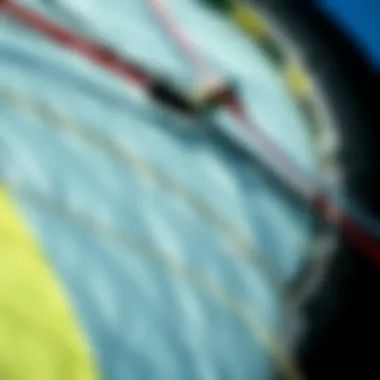
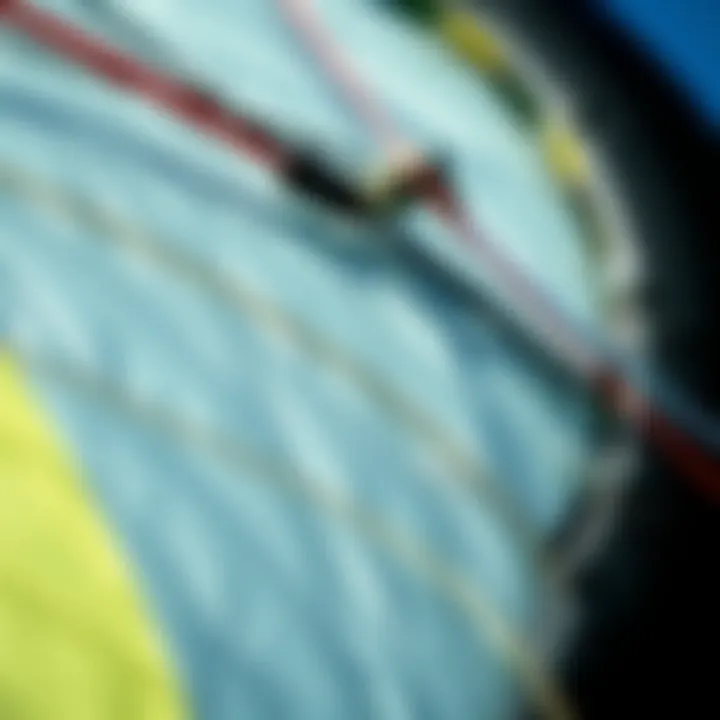
Impact Vest
Impact vests are an often overlooked but critical piece of safety gear. They provide additional protection while riding, minimizing the effects of falls. An impact vest's buoyancy can also assist in floating more easily after a fall, which can be reassuring for beginners still building confidence in the water. Though they don’t provide complete flotation like a life vest, their role in cushioning impacts cannot be downplayed, especially when you’re still falling overboard often.
It's essential to choose gear that matches your comfort level and safety requirements. Every novice should prioritize gear that enhances their confidence and allows them to focus on mastering the basics.
By understanding these core equipment essentials, you're laying a secure foundation for your kitesurfing journey. Each piece plays a pivotal role in ensuring both your enjoyment and your safety while you ride the waves. From kites to harnesses, each aspect deserves thoughtful attention as you prepare to take the plunge into the thrilling world of kitesurfing.
Boarding Basics
Understanding the fundamentals of boarding in kitesurfing is crucial for enthusiasts. It helps beginners learn the ins and outs of maneuvering on the water, bringing confidence to their kitesurfing adventures. This section covers two major aspects: choosing your first kiteboard and comprehending board sizes and shapes. Each element plays an important role in how successful a novice will be in getting started.
Choosing Your First Kiteboard
Selecting the right kiteboard is akin to choosing the right pair of shoes; if they don’t fit or suit your needs, you won’t get far. Every kiteboard has features that cater to specific riding styles, skill levels, and water conditions, making it essential to find one that matches your preferences.
Directional Boards
Directional boards are designed primarily for surfing upwind. This type of board allows for stability and control when navigating waves, making it a compelling choice for beginners who want a more traditional surfing experience. The standout characteristic of a directional board is its asymmetric shape, suited for consistent edge control while riding.
The unique feature of directional boards is their tail shape, which can range from round to pintail. This variation directly influences how the board handles different wave conditions. While it excels in surf-like environments, it can be less versatile for casual jumping and tricks compared to twin tip boards.
Pros:
- Excellent for wave riding
- Improved control when going upwind
Cons:
- Limited versatility for tricks
- Requires specific techniques to maneuver effectively
Twin Tip Boards
Twin tip boards, conversely, offer an all-around experience. They are symmetrical, which means that riders can ride in either direction, making them perfect for beginners still figuring out their style. A hallmark of twin tip boards is their versatility. They let riders perform jumps, tricks, and even spin without the hassle of having to turn the board around.
A unique feature of twin tip boards is their rocker profile – that is, the curvature on the bottom of the board. This influences speed and control. This flexibility allows for easier landings when attempting tricks but can also make it harder to ride efficiently in choppy conditions.
Pros:
- Great for jumps and tricks
- Easy to ride for beginners who want to switch directions easily
Cons:
- Performance may decrease in stronger wind or chop
- Can be less stable when riding upwind compared to directional boards
Understanding Board Sizes and Shapes
Getting to know board sizes and shapes can profoundly impact a kitesurfer’s ability to perform effectively. Various factors, such as rider weight, skill level, and the wind or water conditions, influence the optimal size and shape of a kiteboard. Beginners should aim for boards that provide a large surface area, which offers more stability and ease of use.
Size Matters:
- A larger board gives more lift and can help catch small waves.
- Smaller boards are more maneuverable and suitable for experienced riders who prioritize speed and tricks.
Typical Sizes:
- 130-140 cm: Best for light riders or those under 150 lbs.
- 140-150 cm: Ideal for average riders or those wanting a smoother ride.
- 150 cm and above: Suits heavier riders or those who want stability.
With these essential points, beginners can make informed choices on their starting boards, setting a solid foundation for an enjoyable kitesurfing experience.
The right board can make all the difference between flying high or getting stuck in the water.
By focusing on the right kiteboard and understanding sizing, newcomers to kitesurfing can better navigate their initial experiences on the water, leading to greater enjoyment and skill progression.
Safety Gear Considerations
When venturing into the world of kitesurfing, one must always prioritize safety. The unpredictable nature of wind and water necessitates that beginners equip themselves with the proper safety accessories. Not only do these tools shield you from potential accidents, but they also enhance the overall quality of your kitesurfing experience. If you are serious about making the most out of your time on the water, understanding safety gear is non-negotiable.
The Necessity of a Personal Flotation Device
A Personal Flotation Device (PFD) is by far one of the most crucial pieces of safety gear for any kitesurfer. It is designed to help you stay afloat in case of unexpected mishaps. This buoyancy can be a game changer when you find yourself in challenging conditions, or if your kite unexpectedly drops and you need to regain control.
A reliable PFD not only offers buoyancy but also encompasses features like pockets for storing small essentials. While some folks might think of a PFD as an afterthought, it's a badge of responsibility. Whether you're surfing on a sunny day or navigating choppy waters, wearing a PFD gives you an extra layer of assurance. If you're looking for recommendations, check out various brands like Ronix and Hyperlite for effective options.
Helmet and Its Importance


Wearing a helmet while kitesurfing is like having your seatbelt buckled in a car. Your head is your most vital asset, and it's easy to underestimate the need for protection. Kitesurfing involves high speeds and, potentially, collisions with the water or equipment. A helmet could very well be the deciding factor between a minor bump and a serious injury.
Look for helmets specifically designed for watersports as they tend to have unique features, such as drainage holes, to minimize water accumulation. Brands such as Mystic and Prolimit provide models balancing comfort and safety without compromising on performance.
Wetsuits: Choosing for Comfort and Protection
A wetsuit is vital for both warmth and protection while kitesurfing. Knowing how to choose the right one can significantly impact your performance and enjoyment in the water. Wetsuits contribute to comfort during longer sessions, and they can protect you against scrapes or even potential jellyfish stings.
Thickness Considerations
The thickness of a wetsuit plays a significant role in how well it keeps you warm. Typically measured in millimeters, wetsuit thickness helps maintain your body temperature in cooler waters. For instance, a 3/2mm wetsuit is great for mildly cool conditions, while a thicker 5/4mm is excellent for chillier climates. Opting for a wetsuit that is too thin in colder waters can lead to rapid heat loss, leaving you shivering and even at risk for hypothermia.
Remember, it’s not just about warmth; flexibility matters too. Thicker suits tend to be less flexible, which can limit your movements. Brands such as O’Neill and Rip Curl offer a variety of thicknesses designed for various temperatures and activities.
Type of Wetsuits
When selecting a wetsuit, you also face choices in style—like full suits versus shorties, and even specific cuts designed for kitesurfing. A full suit covers you entirely, which is great for colder months, while a shortie provides more freedom in warmer waters. Each type has its own merits based on the climate you are going to be kitesurfing in.
For instance, a full-sleeve, flatlock seam suit holds up better in colder climates compared to a sleeveless option. On the other hand, shortys are generally favored for warmer weather or for those who want a bit more mobility. Brands like Billabong and Quiksilver have options tailored for various preferences and requirements.
"Safety does not come from the gear itself, but from the mindset of the kitesurfer who uses it."
Staying safe is not only about gear but also about being aware, prepared, and receptive to the conditions around you. Make it a point always to check your equipment and understand how to use it properly. It's an integral part of enjoying a fulfilling kitesurfing journey.
Maintenance and Care of Equipment
When embarking on the exhilarating sport of kitesurfing, understanding the significance of maintenance and care of your equipment can’t be underestimated. Just as a well-tuned engine drives a car efficiently, proper upkeep of your kitesurfing gear ensures stellar performance and safety on the water. With the right approach to maintenance, your gear can last longer, giving you many more adventures and memories in the surf.
To begin, one must recognize that kitesurfing gear takes a beating. Exposure to saltwater, sand, and UV rays can wear down even the most durable equipment. Therefore, keeping your gear in optimal condition requires diligence and routine.
Inspecting and Repairing Kites
Regular inspecting and repairing of your kite is essential. A tiny tear or frayed line, if not addressed, can lead to monumental mishaps out on the water. Here’s how to ensure your kite is always ready for action:
- Visual Inspection: Before each session, take a few minutes to visually check your kite for any obvious signs of damage, such as punctures or wear on the seams. Pay particular attention to the leading edge and the struts, which are high-stress areas.
- Fabric Care: If you notice sand or debris stuck to your kite, rinse it off with fresh water after your session. This tiny step prevents unnecessary abrasion and maintains fabric integrity.
- Repair Kits: Keep a portable repair kit handy. These kits usually come with patches and adhesive specifically designed for kite materials. In case of accidents, you can quickly fix minor damage, keeping you from cutting your session short.
"Regular maintenance and quick repairs not only enhance the lifespan of your kite but also provide peace of mind before heading out into the waves."
Caring for Your Kiteboard
Your kiteboard is just as important as your kite; it�’s your connection to the wind and water. Caring for your board involves a few straightforward steps that are vital for keeping it performing well:
- Cleaning: After every session, wash your board with fresh water to remove any salt residue. Salt can damage the graphic finish and lead to corrosion of hardware over time.
- Storage: Store your board in a cooler, shaded place to avoid prolonged exposure to the sun. Additionally, avoid stacking other heavy items on it, as this can warp the shape of the board.
- Checking the Fins: Regularly check your fin hardware to ensure everything is tight. Loose fins can lead to decreased performance and, worse yet, loss of control during riding.
- Deck Pads: Inspect the condition of your deck pads. If they’re wearing out or peeling, it’s wise to consider replacing them. Adequate grip is crucial for navigating the waves effectively.
Practicing good maintenance habits may seem tedious at times, but the benefits are immense. Keeping your equipment in tip-top shape not only enhances your performance but also keeps your sessions fun and safe. Whenever you prioritize care for your gear, you're not only investing into your enjoyment but ensuring a better experience in every gust of wind that pushes you across the water.
Buying Equipment: Tips for Beginners
When stepping into the world of kitesurfing, it's not just about the thrill of gliding over water and catching wind; the first step is often the hardest one—choosing the right equipment. The gear you invest in can either pave the way to an exhilarating experience or leave you feeling frustrated. Making informed decisions not only helps you enjoy the sport but also enhances your safety out on the water. This section will guide you through the essentials of buying equipment, ensuring you’re well-equipped to navigate the waves.
New vs. Used Gear: Pros and Cons
When considering kitesurfing gear, the choice between brand-new and used equipment is often a hot topic among beginners. Each option holds its own unique set of advantages and drawbacks.
Pros of New Gear:
- Reliability: New gear usually comes with a warranty, ensuring peace of mind regarding potential repairs.
- Latest Technology: Manufacturers regularly improve designs, which means new equipment often reflects the latest innovations in safety and performance.
- Customization: Buying fresh gear can allow you to select sizes and features tailored specifically to your needs.
Cons of New Gear:
- Costly: New kites, boards, and harnesses can put a serious dent in your wallet.
- Rapid Depreciation: Much like cars, new kitesurfing gear loses value the moment it leaves the shop.
Pros of Used Gear:
- Affordable: You often can snag high-quality equipment at a fraction of the price.
- Tested Performance: Equipment that has been gently used can sometimes be a great indication of its reliability and performance.
Cons of Used Gear:
- Wear and Tear: Previous use may affect everything from the kite’s fabric to the board’s integrity.
- Limited Selection: Sizing and customization options might be restricted when shopping for second-hand products.
A keen eye for detail and patience can help you find used gear that’s still up to par, giving you the ability to take to the water without breaking the bank.
Where to Buy Equipment

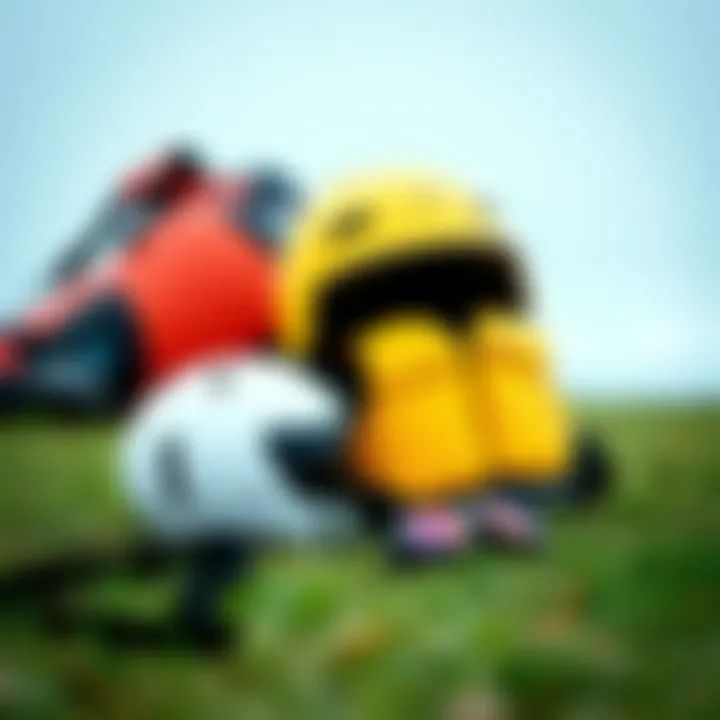
When it comes to purchasing your kitesurfing equipment, location plays a significant role in the experience. There are generally two types of shopping venues: local shops and online retailers, each offering a different flair.
Local Shops
Local shops serve as community hubs for kitesurfing enthusiasts. One distinct advantage of shopping locally is the personalized service. Staff members are usually passionate kiteboarders themselves, offering valuable insights and tailored recommendations based on your skill level and preferences.
Here are some key characteristics that make local shops a beneficial choice:
- Hands-On Experience: You can physically check the gear, providing a sense of comfort about your purchase.
- Immediate Acquisition: No need to wait for shipping; you can usually take your gear home right away.
- Community Engagement: Many local shops host events, helping you connect with fellow kiteboarders.
However, it’s worth noting that prices may be higher than online retailers, and selection can be limited based on inventory.
Online Retailers
Online retailers are like treasure troves filled with kitesurfing gear. Offering a broader range of brands and products, they cater to different financial constraints and preferences.
Key characteristics of online shopping include:
- Price Comparisons: You can easily compare prices among various distributors, helping you find the best deal.
- Greater Selection: There’s often a wider range of equipment available, from various brands to specific models tailored to your needs.
- Convenience: Shopping can be done from the comfort of your home, at any hour.
While the benefits are substantial, some drawbacks come into play:
- No Physical Inspection: You can't try the gear until it arrives, which can lead to unfortunate surprises if the fit or quality doesn’t meet your expectations.
- Shipping Delays: Depending on where you live and shop, waiting for your order can take longer than anticipated.
In summary, it’s prudent to weigh your options. Whether you opt for the personal touch of a local shop or the expansive offerings of an online retailer, your choices can significantly impact your kitesurfing journey.
Consider this a crucial step toward your excitement and adventure on the water.
Future Trends in Kitesurfing Equipment
The landscape of kitesurfing equipment is continually evolving, making it essential for both novices and seasoned riders to stay informed about what new gear is on the horizon. Embracing future trends can enhance performance, safety, and environmental impact. Understanding these trends provides a framework for making smarter purchasing decisions and navigating the ever-changing kitesurfing market. In this section, we will delve into innovations that promise to enhance the riding experience while also touching on the crucial aspect of sustainability in equipment manufacturing.
Innovations Enhancing Performance
Recent advancements in technology have significantly reshaped how kitesurfers interact with their equipment. From kites designed with better aerodynamics to boards that can withstand varied conditions, innovation plays a vital role.
- Smart Kites: These are the game changers. Equipped with sensors, smart kites can adjust to wind conditions on-the-fly, providing optimal performance without the rider constantly monitoring the wind. This results in less fatigue and greater enjoyment on the water.
- Lightweight Materials: Modern materials, such as carbon fiber and advanced nylon composites, make equipment lighter and more durable. Riders can expect greater responsiveness and agility, which could make the difference between a smooth ride and a struggle against the wind.
- Improved Depower Systems: Enhanced depower mechanisms allow riders to adjust the input from the kite effortlessly, providing a safer way to handle varying wind conditions. This feature can be especially valuable for beginners who may not yet have mastered the nuances of controlling their kites.
"Innovation in kitesurfing isn't just about new toys; it's about elevating the experience to match the thrill nature offers."
Transitioning to riding conditions that may have once been deemed unsuitable becomes easier as these innovations reduce the learning curve. By understanding and adopting these technologies, kitesurfers can enjoy an enriched experience, riding with confidence regardless of the conditions.
Sustainability in Equipment Manufacturing
As the global community becomes increasingly aware of environmental impacts, the kitesurfing industry is not falling behind. New approaches in sustainability are beginning to influence equipment design and manufacturing, which speaks to the heart of our shared responsibility.
- Eco-friendly Materials: Various brands are now incorporating sustainable materials into their designs. Biodegradable fabrics, recycled plastics, and sustainable production practices are more common, paving the way for environmentally conscious kitesurfers to make informed choices.
- Minimal Waste Practices: Companies are adopting practices that minimize waste throughout the manufacturing process. This not only reduces the ecological footprint of each board or kite produced but also resonates with a growing consumer demand for responsible manufacturing.
- Repairability: An increasing number of brands are focusing on creating kites and boards that can be easily repaired rather than discarded. This encourages a culture of maintenance rather than waste, allowing kitesurfers to extend the life of their equipment significantly.
Being aware of these trends is more than just a matter of preference; it points to an emerging tide of thought about our collective impact on the planet. Kitesurfing communities can take pride in integrating sustainability into their sport, ensuring that this exciting activity can be enjoyed by future generations.
In summary, keeping up with innovations and sustainable practices is not just beneficial but essential for anyone involved in kitesurfing. These developments will undoubtedly continue to shape the future of the sport, enhancing the overall experience while ensuring a healthier planet for all.
Epilogue: Preparing for Your Kitesurfing Journey
As you wrap up your exploration into the world of kitesurfing equipment, it's essential to acknowledge how crucial preparation is for a fun and safe experience. Your journey on the water is not solely about conquering the waves but also about making informed decisions regarding the gear that will accompany you. Setting up a solid foundation means understanding your needs and the capabilities of your equipment.
The right gear empowers confidence. For those just starting, a well-thought-out choice in kites, boards, and protective gear can truly make all the difference. When you're kitesurfing, every piece of your equipment plays a role, whether it’s keeping you afloat or enhancing your riding experience. Safety should always be a top priority—after all, no one wants a nasty fall in a sport where winds and waves reign supreme.
Preparation is key to safety and performance; understanding your gear helps to maximize your kitesurfing adventure.
Your gear cannot only assist in your immediate performance but also influence your growth as a kitesurfer. Investing time in learning about different types of kites or wide-ranging boards gives you the advantage of tailoring your experience to your comfort levels and skill.
While heading toward the beach, take a moment to gather everything you need—this is where a final equipment checklist becomes indispensable.
Final Equipment Checklist
Having a checklist ensures you won’t forget that crucial item, potentially saving you from a frustrating trip back to the store. Here are a few key elements you should consider when preparing for your kitesurfing adventure:
- Kite: Ensure it is in good condition, with no tears or leaks.
- Board: Choose one that fits your skill level, whether it's a twin tip or directional board.
- Harness: Pick a comfortable option, be it a waist or seat harness, depending on your preference.
- Safety Gear: Do not neglect your PFD and helmet—safety first!
- Wetsuit: Depending on your local conditions, find the right thickness for warmth and protection.
- Control Bar and Lines: Double-check for wear and tear before hitting the water.
By checking off these essential items, you can focus on the thrill of riding rather than worrying about forgotten gear.
Next Steps to Take After Acquiring Gear
After you've acquired your equipment, the next steps are critical in nurturing your kitesurfing journey. Often, initial purchases can feel overwhelming. However, here's where clarity comes into play.
- Get Professional Lessons: Nothing beats the expertise of a trained instructor. They not only teach you the basics but also provide insights into how to handle your equipment effectively.
- Practice Safety Protocols: Familiarize yourself with safety measures relevant to your local kitesurfing environment. Understanding wind patterns and water conditions is vital for your well-being.
- Join a Community: Connect with other kitesurfers through local clubs or social media groups. This opens up discussions about gear, experiences, and even finding buddies to kite with.
- Invest in Your Skills: Once you're comfortable, consider additional courses to enhance your skills. This could lead to more advanced maneuvers and techniques.
- Stay Updated on Equipment Trends: Kitesurfing equipment evolves rapidly. Keeping abreast of new technologies or safety gear can enhance your performance and enjoyment.
By taking these steps, you're not simply preparing for a day at the beach; you're investing in a lifelong adventurous pursuit. Kitesurfing is a beautiful blend of physical skills, mental focus, and connection to nature. Embracing your journey, armed with the right knowledge and gear, will set you up for success on the waves.

